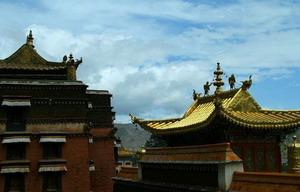Labrang Monastery is one of the six great monasteries of the Geluk (Yellow Hat) school of Tibetan Buddhism. La brang is located in Xiahe County in Gansu province. Labrang Monastery is home to the largest number of monks outside of Tibet Autonomous Region.
brang is located in Xiahe County in Gansu province. Labrang Monastery is home to the largest number of monks outside of Tibet Autonomous Region.
History of Labrang Monastery
"Labrang" means the residence of a great Lama. The monasery in general became known as Labrang, or Labrang Tashikyil, after the residence of Jamyang-zhaypa. The line of his reincarnations, the Jamyang-zhaypa Rinpoches, have been the traditional heads of the Labrang Monasery.
There has always been a strong connection between Labrang Tashikyil and the Mongols. Many lineages from Labrang, such as that of Kalachakra (Dus- khor), spread to the Mongolian monaseries. The Buryat, Kalmyk, and Tuvinian regions of Russia used exclusively the Kunkyen textbooks of Jamyang-zhaypa. Many monaseries in Inner and Outer Mongolia used them as well. In Lhasa, the Mongols mostly studied at Gomang and Gy| umay, as did Jamyang-zhaypa. Labrang has six colleges. The largest is Mayjung Tosamling (sMad-byung Thos-bsam-gling), for the study of sutra and debate, established by the First Jamyang-zhaypa in 1710 when he founded the monasery in general. It awards the Geshey Dorampa (dGe-bshes rDo-ram-pa) degree. When the First Jamyang-zhaypa received the Say lineage (Srad-brgyud) transmission at Saygyu Tantric College (Sras-rgyud grva-tshang) from Saygyu Konchog-yarpel (Srad-rgyud dKon-mchog yar- phel) (1602-1682), this great master asked him to establish a tantric college as part of the monasery he would found in Amdo in the future. Keeping this request in mind, the First Jamyang-zhaypa established Maygyu Dratsang (sMad-rgyud Grva-tshang), Lower Tantric College, in 1719. The Dukor Dratsang (Dus- khor Grva-tshang) or Kalachakra College, Ewam-chokor-ling (E-wam chos- khor gling), was founded in 1763 by the Second Jamyang-zhaypa, Konchog-jigmey-wangpo (dKon-mchog jigs-med dbang-po) (1728-1798), on the advice of the Third Panchen Lama, Pelden-yeshey (Pan-chen dPal-ldan ye-shes) (1738-1780). The Panchen Lama s home monasery, Tashilhunpo (bKra-shis lhun-po), built a Kalachakra temple (Dus- khor lha-khang) two years later, in 1765, devoted to the daily practice of the Kalachakra rituals. Since the first half of the eighteenth century, Kalachakra Colleges had already existed in Inner Mongolia. The first was at Ari-in Monasery, founded by the First Kanjurwa Gegen, Lozang-choden (bKa - gyur-ba Blo-bzang chos-ldan), and the second at Badghar Monasery (Pad-dkar dGon-pa) by his disciple, Dunkhor Pandita (Dus- khor Pandi-ta). The Dukor Datsang at Labrang was the first of its kind in Amdo. The Menpa Dratsang (sMan-pa Grva-tshang) or Medical College, Sorig-zhenpen-ling (gSo-rig gzhan-phen gling), was established in 1784, also by the Second Jamyang-zhaypa. The Kyedor Dratsang (Kyai-rdor Grva-tshang) or Hevajra College, Sangngag-dargyay-ling (gSang-sngags dar-rgyas gling), was started by the Fourth Jamyang-zhaypa, Kelzang-tubten-wangchug (sKal-bzang thub-bstan dbang-phyug), in 1879. The Gy| to Dratsang (rGyud-bstod Grva-tshang) or Upper Tantric College, Sangchen-dorjey-ling (gSang-chen rdo-rje gling), was established in 1943 by the Fifth Jamyang-zhaypa, Lozang-jamyang-yeshey-tenpay-gyeltsen (Blo-bzang jam-dbyangs ye-shes bstan-pa i rgyal-mtshan). The two Tantric Colleges at Labrang, like their models in Lhasa, studied mostly the Guhyasamaja (gSang- dus), Chakrasamvara (bDe-mchog), and Vajrabhairava (rDo-rje Jigs-byed) tantric systems. They awarded Geshe Karamapa (dGe-bshes bKa -ram-pa) and Geshe Ngagrampa (dGe-bshes sNgags-ram-pa) degrees, as at the two Lhasa Tantric Colleges. The Kalachakra College was responsible for not only the Kalachakra rituals, but also those of Samvid (Kun-rig) and Vairochana Abhisambodhi (rNam-snang mngon-byang). The monks of the Kalachakra College also studied astronomy, astrology, and mathematics. In addition to medical studies, the monks of the Medical College were responsible for the rituals of the Medicine Buddha (sMan-lha), Akshobhya (Mi- khrugs-pa), and the Hiddenly Realized (gSang-sgrub) form of Hayagriva (rTa-mgrin). The Hevajra College maintained the rituals for Hevajra and Vajrapani Mahachakra (Phyag-rdor Khor-can), and prepared a calendar/almanac each year according to the Chinese-style black calculation system (nag-rtsis). As at the Jokang (Jo-khang) in Lhasa, every year from the 3rd to the 17th of the first Tibetan month, Labrang held a Great Prayer Festival (sMon-lam chen-mo) with examinations for the highest grades of Geshe. At this festival, there were ritual masked dances and other rites as in Lhasa. At its height in 1957, Labrang had nearly 4,000 monks. About 3,000 of them were at the Mayjung Tosamling College, with the rest evenly distributed among the other five colleges. Approximately three-quarters of the monks were Tibetans. The rest were mostly Outer Mongolian Mongols (phyi-sog), Inner Mongolian Mongols (smad-sog, nang-sog), Kokonor Mongols (stod-sog), Mongours (hor-pa) from northern Amdo, Yellow Yugurs (yu-gur) from Gansu (Kansu), Xinjiang Kalmyk Mongols, and ethnic Chinese. Labrang had 138 branch monaseries. Starting in 1958, the monasery was closed for twelve years by the Chinese. During the 1970s, it was opened for tourism. It was reopened as a functioning monasery by the Seventh Panchen Lama, Chokyi-gyeltsen-trinley-lhundrub (Pan-chen Chos-kyi rgyal-mtshan phrin-las lhun-grub) (1938-1989), in 1980. At present there are about 500 monks, divided among the six colleges in the same proportions as before. The study program is only a fraction of what it previously had been.




